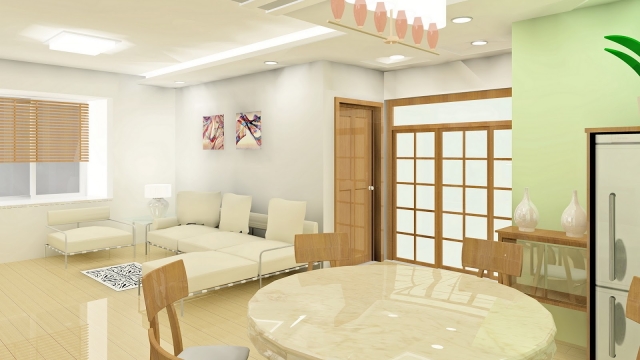In the world of design, there exists a captivating realm where architecture and interior design converge to create harmonious spaces that leave a lasting impression on our senses. The interplay between these two disciplines harmonizes structure and aesthetics, resulting in breathtaking environments that evoke both functionality and beauty. With a deep appreciation for form, function, and the expressive power of space, architects and interior designers work tirelessly to turn empty canvases into captivating works of art. Welcome to the world where the realms of Architecture and Interior Design seamlessly blend, inviting us to explore the transformative synergy that lies at their core.
The Role of Architecture in Shaping Interior Design
When it comes to creating harmonious spaces, the role of architecture cannot be overstated. Architecture lays the foundation for interior design, setting the stage for how a space will function and feel. It is the backbone upon which the aesthetics and functionality of interior design are built.
The scale, structure, and layout of a building are determined by its architectural design. Whether it’s a soaring skyscraper or a cozy cottage, the architectural framework dictates the overall form and proportions of the space. This framework influences the flow and movement within the interior, guiding how people interact with the environment.
The architectural elements, such as walls, windows, and doors, also play a significant role in shaping interior design. These elements act as the canvas on which interior designers paint their vision. The placement of windows determines the natural light that floods the space, while walls create boundaries for various functional areas. Doors provide access and separation, allowing for privacy and different spatial experiences.
In addition to form and structure, architecture also influences the selection of materials, colors, and textures used in interior design. The choice of building materials, such as wood, stone, or glass, can inspire the interior design’s aesthetic direction. The architectural style, whether it’s modern, traditional, or minimalist, can set the tone for the overall ambiance. The textures and finishes seen on the exterior can be mirrored or contrasted within the interior, creating visual harmony or exciting juxtapositions.
Overall, architecture acts as the guiding force that shapes interior design. It establishes the framework, provides functional elements, and inspires the aesthetic choices. A successful collaboration between architecture and interior design leads to spaces that seamlessly integrate form and function, resulting in harmonious environments that delight and inspire those who inhabit them.
Creating Seamless Transitions between Indoor and Outdoor Spaces
The integration of indoor and outdoor spaces has become an essential aspect of modern architecture and interior design. By blurring the boundaries between these two realms, designers can create a harmonious flow that enhances the overall experience of a space.
One key element in achieving seamless transitions is the strategic placement of windows, doors, and other openings. The careful positioning of these features allows for a visual connection between the interior and exterior, while also inviting natural light and ventilation into the space. Large, floor-to-ceiling windows can serve as frames, offering picturesque views of the surrounding landscape and creating a sense of unity with nature.
Interior Design
In addition to thoughtful openings, the choice of materials is crucial in creating a smooth transition between indoor and outdoor spaces. Incorporating similar colors, textures, and patterns in both areas can help establish a visual connection and a sense of continuity. For example, using similar flooring materials—such as stone or wood—both inside and outside the building can create a seamless flow, further enhancing the synergy between the two spaces.
Furthermore, the integration of outdoor elements inside the building can also help to bridge the gap between indoor and outdoor environments. Incorporating elements like plants, green walls, or water features not only adds to the aesthetic appeal but also reinforces the connection to the natural world. By bringing nature indoors, designers can create a sense of tranquility and serenity that transcends traditional boundaries.
In conclusion, creating seamless transitions between indoor and outdoor spaces requires careful consideration of various design elements. From strategic placements of openings to the choice of materials and the incorporation of outdoor elements, designers can achieve a harmonious flow that blurs the boundaries between the inside and outside. Ultimately, this synergy enhances the overall experience of a space, fostering a sense of balance, tranquility, and connection to the natural world.
Enhancing Functionality and Aesthetics through Collaboration

In the world of architecture and interior design, collaboration is key to creating harmonious and impactful spaces. By combining their expertise and working together, architects and interior designers can enhance both the functionality and aesthetics of a project.
One way collaboration can enhance functionality is through thoughtful space planning. Architects consider the overall layout and flow of a building, while interior designers focus on optimizing individual rooms and areas. Through close collaboration, they can ensure that spaces are designed with the needs and activities of the occupants in mind, maximizing efficiency and usability.
Additionally, collaboration between architects and interior designers can greatly enhance the aesthetics of a space. Architects bring a unique vision and understanding of external factors such as site context and natural light, while interior designers shape the internal environment in terms of materials, colors, and furnishings. By working together, they can create a cohesive design that seamlessly integrates the external and internal elements, resulting in a visually appealing and balanced space.
Furthermore, collaboration fosters innovation and creative problem-solving. Architects and interior designers can bounce ideas off each other, sparking new concepts and pushing the boundaries of design. By leveraging their individual strengths and perspectives, they can create distinctive spaces that go beyond convention, captivating and inspiring those who experience them.
Through collaboration, architecture and interior design can merge seamlessly, creating spaces that are not only aesthetically pleasing but also highly functional. This synergy between the two disciplines allows for the creation of harmonious environments that enrich the lives of those who inhabit them. The art of harmonious spaces is truly a product of the collaborative efforts of architects and interior designers, showcasing the power of collaboration in the field of design.


